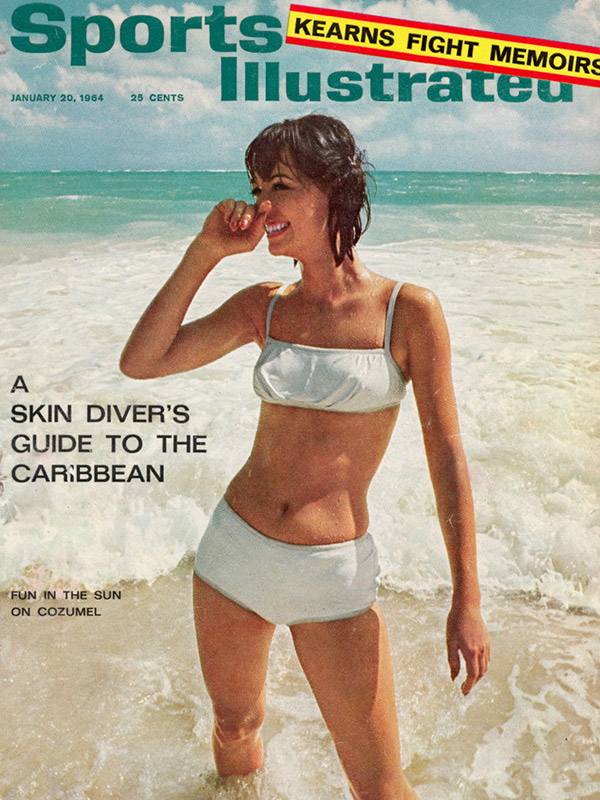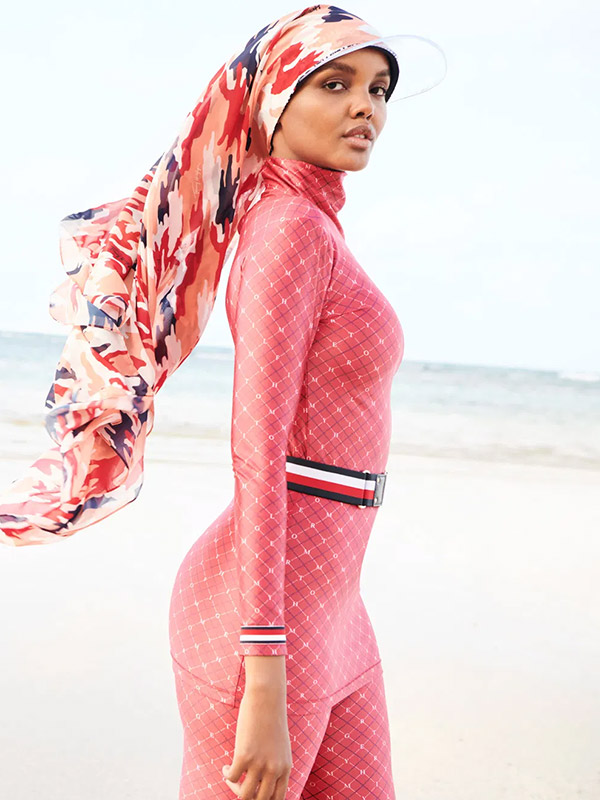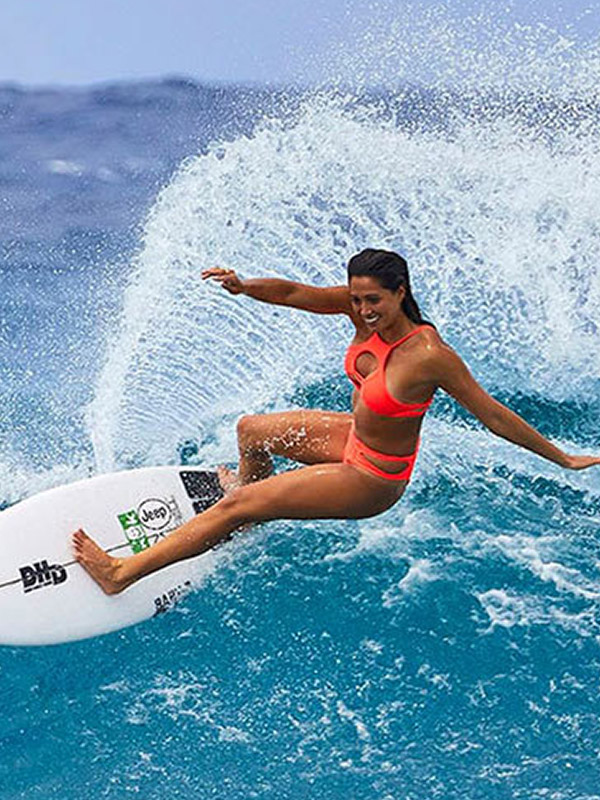While writing our article on the history of the bikini, we were reminded of how the first Sports Illustrated Swimsuit issue debuted back in 1964. That got our brain working into overtime about the long history of the seminal magazine issue, the magazine issue’s cultural impact, and our place within that story.
We’ve been lucky, blessed, and fortunate enough to have our bikinis be featured in Sports Illustrated Swimsuit Edition for nine consecutive years, including the 2020 issue (which dropped July 13th FYI), and we were lucky enough to have Margot Zamet, from Sports Illustrated Swimsuit contribute to this piece too! Without the magazine legitimizing the bikini as a piece of women’s fashion, TeenyB would not be TeenyB!
A (Condensed) History of the Sports Illustrated Swimsuit Edition

As we previously wrote, the first issue of the Swimsuit Edition was released on January 20th, 1964 and featured the German-born model Babette March for a five-page spread. Originally the idea came from the then-editor Andree Laguerre charged young-fashion reporter Jule Campbell with the simple decree: how would you like to go to some beautiful place and put a pretty girl on the cover?
However, unlike today’s annual SI swim releases, the first SI swimsuit edition was created as almost an after-thought during a time when the bikini did not have the same cultural ubiquity it enjoys today. In a move that looked to simply fill the magazine’s pages during a slow winter month, the issue launched both March’s career and magazine into the media phenomena it is known as today.
From then on (or at least until 1997), the annual issue featured a five-page spread of a selected model while still sharing the spotlight with the day’s sports stars, but during that time and under Campbell’s guidance, the “swimsuit” editions would feature the model’s name and go against the then-current archetype of 60’s beauty – epitomized by the British-born model Twiggy – in favor of “bigger and healthier California women”.
Campbell’s practice of publishing the model’s name ushered in an era that allowed the magazine to create supermodels and from then onward, models such as Cheryl Tiegs, Elle Macpherson, Heidi Klum, Tyra Banks, and more have become household names in no small part because of Campbell’s foresight.
Controversy Comes with Success
While the SI swimsuit edition achieved mainstream success due in part to Campbell’s guidance, the annual issue also had its detractors throughout the years. From those who moralize against depictions of female sexuality, to those who don’t see the point of having fashion included in a sports magazine, to some feminists who argue that swimsuit issue “promotes the harmful and dehumanizing concept that women are a product for male consumption”.

Most notable being Cheryl Tiegs’s infamous white fishnet photo in the 1978 edition caused an uproar which resulted in 340 cancellations. Often, various think pieces and other talking heads discuss the overall merit of the annual issue; debating whether it empowers women or objectifies them. That being said, it should be also noted that throughout the edition’s history, the majority of editors have been women.
However since 2005, cancellations of the magazine have declined and in 2007 Sports Illustrated has allowed its subscribers to waive receiving the swimsuit edition for a one-issue credit to keep their subscription.
Towards Inclusivity
Over the years, various charges of objectifying women, sticking to a “certain” type of model (read: not Black, Latina, Asian, or any other ethnic group outside of white), and portraying shall we say “specific body types” that do not accurately reflect what “real” women look like have been leveled against the magazine. And for a large majority of the edition’s history that was indeed the case.

While Maria Joao was the first Latina to be featured on the front cover in 1978, for most of the magazine’s history, the charges outlined above have indeed been par for the course. It was not until 1997 when supermodel Tyra Banks was featured solo on the front cover (she did appear on the front cover alongside Valeria Mazza in 1996 though), making her the first African-American to be featured on the cover of the magazine in its then 33-year history.
Since 1997, the swimsuit edition has been evolving beyond what its original intent of “pretty girls in swimsuits”. Under the deft and careful direction of editor MJ Day, the brand has matured alongside a rapidly changing industry where the boundaries of beauty have become less restrictive.
The magazine began publishing Swim Daily online (now Sports Illustrated:Swimsuit) in 2013 that showcases content beyond the traditional once-a-year model of the Swimsuit edition to illustrate its models not just as models, but as women with aspirations, hobbies, and dreams – as people not just supermodels or standards of beauty.
In 2017, MJ herself posed in a bikini on Instagram to celebrate the #WhatIModel campaign – which aimed to empower woman of all shapes and sizes to celebrate one’s inner strength and beauty. That year’s Swimsuit edition also featured a wide range of models from SI veteran Christie Brinkley (and her daughters) as well as Hunter McGrady.

Most recently, in the 2019 issue featured great strides in inclusion and diversity featuring a wide range of women from Halima Aden’s burkini photoshoot, Paulina Porizkova after a gap of 36 years between her first appearance, and featuring Alex Morgan (with her U.S. national soccer teammates Megan Rapinoe, Crystal Dunn, and Abby Dahlkemper) shortly after suing the U.S. Soccer Federation for gender discrimination and equal pay.
The 2019 edition also featured many articles that broached the Me-Too Movement, body types, and ageism. Meanwhile, the 2020 issue continued SI’s move towards inclusivity by featuring the first openly transgender model Valentina Sampaio on the front cover. Margot echoed this sentiment, saying “there’s definitely no turning back and there’s always room for improvement. Diverse representation will always be a priority”.
Additionally, the Swimsuit Edition has seen a greater trending toward the use of social media. As print mediums like magazines have slowly seen their readership numbers dwindle, Sports Illustrated and the Swimsuit edition has continued to remain relevant and vital in the social media age. Margot commented that social media, in particular Instagram, “has allowed us to showcase our models further than a beautiful photo, but to give insight on each of them and why they represent what we stand for as a brand. Instagram may have a long list of pros and cons, but for us, we are able to utilize it in a positive, uplifting manner”.
We at TeenyB are excited to see what the future holds as the Swimsuit Edition continues to explore the diverse range of femininity that exists.
TeenyB’s Place within the Story

Looking back at the long history of the magazine and how they are reinventing themselves makes us reflect on just how truly blessed we are that our bikini tops and bottoms are chosen to reflect Sports Illustrated’s commitment to expanding what “beauty” is to include all shapes and sizes.
It also makes us proud to be included in such a historied and seminal piece of culture. The magazine issue almost single-handedly legitimized the bikini as a piece of fashion and in essence allowed TeenyB to become TeenyB and for that, we are forever grateful.